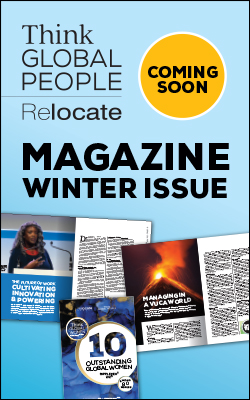Men Stepping Forward – How men can become change makers for diversity and inclusion in organisations
Why is it that despite the best efforts of organisations to encourage diversity and inclusion, and all the resources spent on women’s leadership and training, there are still so few women at the very top of organisations? That is the question that Elisabeth Kelan, Professor of Leadership and Organisation at Essex Business School, University of Essex, set out to research in her ground-breaking book, Men Stepping Forward - Leading Your Organization on the Path to Inclusion.


This article is taken from the Spring 2024 issue of
Think Global People magazine
Click on the cover to access the digital edition.In the book, which is based on 11 years of research, she argues that the idea of finding a “quick fix” to help increase the number of women in senior roles is far from straightforward. While many organisations have put a lot of effort into implementing diversity and inclusion programmes, the issue is complex and achieving true gender equality will take longer than expected. She argues that most research and interventions have attempted to “fix the women”.Instead, the book discusses how men can become ‘change makers’ and lead their organisation towards inclusion, becoming involved in creating gender-inclusive cultures in their organisations. It suggests practical actions for men as leaders and managers to implement in order to make real changes, based on the extensive research which Professor Kelan conducted while writing the book.

Why should men help?
“In my book I suggest that achieving gender equality in organisations is not only women’s work,” says Professor Kelan. “It requires men too. Men however have traditionally been excluded – either implicitly or explicitly - from discussions around gender equality.”She says many organisations want to achieve gender equality but only focus on women to achieve this.“The focus was on developing women,” she writes in the book. “While nothing is wrong with this as such, I increasingly felt that cultures of organisations have to change to allow for inclusion to flourish.“While for instance women’s leadership programmes are useful, they only get you so far if you have leaders in the organisation who do not know how to achieve gender equality. The majority of those leaders are going to be men. It therefore makes a lot of sense to help men in leadership roles to understand what they can do for gender equality,” she says.Her first study was based on CEOs who were supportive of gender equality and had publicly lent their support to create gender equality in their organisation. In other words, they were seen as pushing forward gender relations and were supportive of gender equality in their organisations. With most CEOs being men, the project was largely about what men can do for gender equality.“During the CEO project, one of the CEOs told me that his ability to create change in regard to gender equality in the workplace is rather limited. In other areas you can bring about great change, but with gender equality, it is much more difficult,” she says. “I asked him why that was the case and he responded that this is due to the ‘permafrost of middle management’. In his view, it was difficult, if not impossible, to melt the permafrost of middle management to allow middle managers to change their ways towards more gender inclusive behaviours. Particularly men who are the majority in middle management positions, were constructed as difficult to engage.”This inspired a second piece of research which was guided by the question what men in middle management positions can do to create greater to create gender equality in the workplace.Professor Kelan worked with a range of organisations to identify middle managers who were perceived as doing gender inclusion well. She found this to be a difficult task because many organisations “struggled to identify a man in a middle management session who they perceived as leading on gender equality”, she says. Eventually, she identified men in middle management positions who walked the talk on gender equality. She job shadowed them to document and analyse how they support gender equality in the work context.
Who is the message aimed at?
“My book Men Stepping Forward addresses men and particularly those in leadership positions directly,” she says. “The book is based on my academic research that I conducted for over a decade. However, the book itself is immensely practical. I provide a lot of anecdotes and examples of how men can create inclusion. I also have practical tips and tricks that help men to become change makers for gender equality.”In the book she describes the plethora of initiatives that are designed to develop women leaders. These range from women's leadership development programmes to coaching to make gender biases more visible.“While all of these activities might be worthwhile, a more holistic and systematic perspective on gender in organisations is required,” she says.The glass ceiling describes the phenomenon that women have the top of the organisation in sight yet cannot reach it, she writes. However, rather than just facing a glass ceiling, women have to confront a labyrinth of leadership with many twists, turns and dead ends.Yet unlike other changes which leaders attempt to implement in organisations, gender is a profound change process that organisations embark on. This is because achieving gender equality is deeply connected to how societies are structured, she argues. Gender expectations continue to exist and shape society, yet if we fail to acknowledge this, we see change in gender relations as simplistic uncomplicated.“Many organisations aim to alter gender relations just like they would tackle other issues, setting targets measuring and taking mediating actions when things do not work out,” she says. While this might work with standard business problems, gender is not a standard business issue, because it harks back to how societies are organised based on gender lines.“Putting a change programme for gender in place and expecting it to yield results in the next quarter is highly unrealistic,” she writes. “The reason for the slow progressive change in spite of a myriad of initiatives is likely to be found in a simplistic understanding of gender. Most organisations focus on the obvious, increasing the number of women, without seriously considering how gender is embedded into the structures of the organisation itself.”How work is organised, how it is allocated and who gets credit for it is still heavily influenced by perceptions of gender. The most enlightened organisations have started to look at these micro practices to ensure that women can work on career advancing projects or get stretch assignments that develop their leadership skills. Others have started to ensure that bias is not creeping into evaluations. However, changing gender patterns takes time. It also requires organisations to not only focus on changing women, but also changing on changing the system of how organisations work, she says.Related reading
- Allyship and effective networking – a strategy for transforming women’s career opportunities
- ‘Inspire inclusion’ this 8 March at the Institute of Directors
- Deconstructing the glass ceiling: women’s paths to leadership
What steps can men take?
“In Men Stepping Forward I suggest three concrete steps that men can take to become change makers for gender inclusion,” she says. “First, men need to develop a vision about why they support gender equality. Second, men need to engage in gender equality efforts by for instance explaining to others why gender equality is important and how to achieve. Third, men need to role model what gender inclusive leadership looks like to other.“I suggest that men becoming change makers for gender equality is a learning journey that is also very personal to each man. The book is designed to support men to figure out how being a change maker for gender equality might look for them.”She argues that change makers for gender equality can be found anywhere in the organisation from the CEO right down to frontline service staff.Research has shown that women who are change agents for gender equality are less effective because it is presumed that they are engaging in the change process for instrumental reasons. It was presumed that women are advocates for gender equality because this can advance their own career.“Men in contrast are seen as more effective advocates for gender equality for the opposite reasons,” she writes. “Their engagement is seen as altruistic, because they do not seek to advance their own career opportunities.”While men can actually advance their careers to being changemakers for gender, the common perception is that men are changemakers for gender equality without experiencing personal gains. If men engage in gender equality, this might also be a particularly powerful statement, because someone from the majority is driving change on behalf of a group that has been disempowered.For this reason, she argues, men therefore can be particularly effective as change agents. It is not enough to focus on women and develop them as leaders - there needs to be a focus on men and how they can help facilitate change.She sets out a framework which can be used to act and think like a change agent for gender equality:- change agents are individuals who drive change in an organisational context
- change agents are individuals who often work outside of the formal structure and without formal authority to drive change projects
- they work across established boundaries and organisational silos to make change happen
- often they do their work through convincing others passionate about the change, but also respect that change takes time
- to be a change maker, you have to convince others of the importance of gender equality and be passionate about this topic, but also respect others might take longer to join you on the path.
Join us on 8 March at the Institute of Directors. Book your place here.

Join us on 8 March at the Institute of Directors. Book your place here.
Sponsorship opportunities are also available to show how your company is inspiring inclusion for sustainable growth.
Find out more about the Think Global People community and events.
Subscribe to Relocate Extra, our monthly newsletter, to get all the latest international assignments and global mobility news.Relocate’s new Global Mobility Toolkit provides free information, practical advice and support for HR, global mobility managers and global teams operating overseas.
©2025 Re:locate magazine, published by Profile Locations, Spray Hill, Hastings Road, Lamberhurst, Kent TN3 8JB. All rights reserved. This publication (or any part thereof) may not be reproduced in any form without the prior written permission of Profile Locations. Profile Locations accepts no liability for the accuracy of the contents or any opinions expressed herein.






































